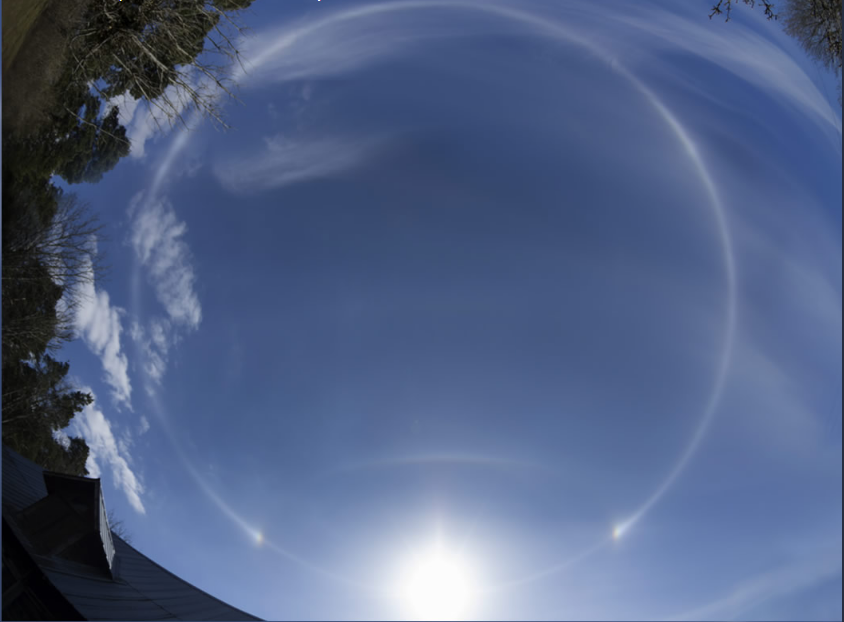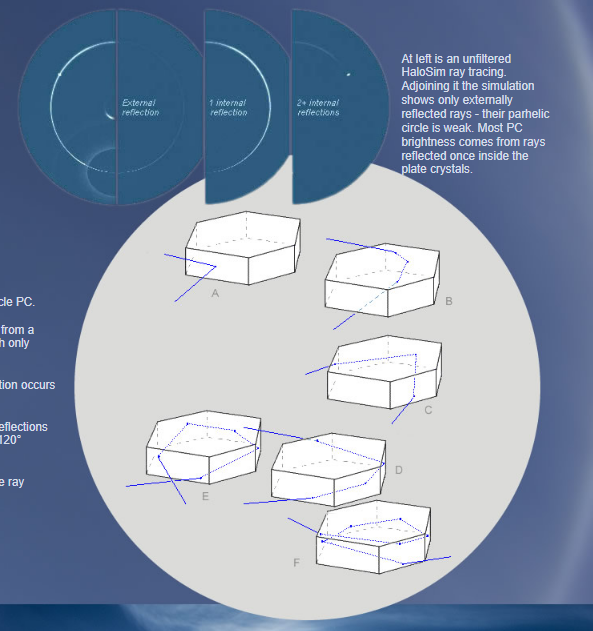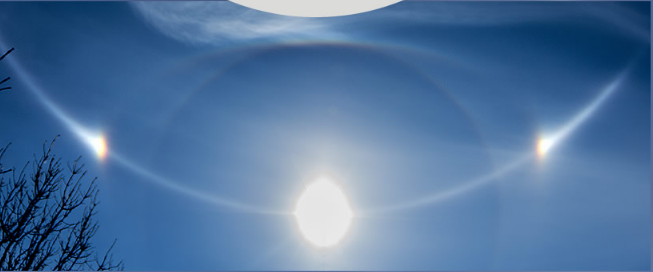OPOD - Complete Parhelic Circle
The Complete Parhelic Circle: A Phenomenon of Atmospheric Optics
The parhelic circle, a captivating atmospheric optics phenomenon, has been observed in various locations around the world. One notable sighting occurred in Gotland, Sweden, as captured by Måns Hagberg. The image, a composite of two photographs, showcases an unusually complete parhelic circle. Unlike other atmospheric halos such as the circumzenithal and circumhorizon arcs, the parhelic circle lacks significant coloration. However, it compensates for this by featuring bright spots, often resembling extra suns, scattered throughout its formation.
Crystal Structures and Sunlight Interaction
The parhelic circle is a result of the interaction between sunlight and ice crystals in the atmosphere. Plate crystals and horizontal column crystals play key roles in its formation. Plate crystals create the extra suns, also known as parhelia, which appear at angles of 22° and 120° from the sun. In some cases, such as a display observed in Sweden in 1535, six suns have been reported.
Horizontal column crystals, on the other hand, contribute to the formation of the circumscribed halo. This halo appears above and around the sun and coincidentally intersects with the sundogs. As the sun's elevation increases, the sundogs move further away from the sun, causing the circumscribed halo to contract and eventually form a circle. This overlap with the parhelia occurs at a sun elevation of approximately 41°.
The Complexity of the Parhelic Circle
The parhelic circle is one of the most complex atmospheric halos due to the multitude of ray paths and crystal orientations involved in its formation. Various ray-tracing simulations provide insights into the different paths that contribute to the parhelic circle's brightness and structure. These simulations reveal that externally reflected rays, which contribute weakly to the parhelic circle, play a minor role in its overall appearance. The most efficient rays are those that experience internal reflection within the ice crystals.
Different ray paths contribute to the parhelic circle's formation, resulting in its unique characteristics. Some of these paths include:
- External reflection from a plate side face, which primarily contributes near the sun.
- Reflections occurring inside the crystal, which are the most efficient in forming the parhelic circle.
- Exotic paths involving multiple internal reflections, which illuminate the parhelic circle away from the sun and also contribute to the formation of the 120° parhelia.
The Contribution of Horizontal Column Crystals
While plate crystals play a significant role in the formation of the parhelic circle, horizontal column crystals also contribute to this atmospheric phenomenon. The presence of horizontal column crystals adds additional ray paths to the overall structure of the parhelic circle. The combination of plate crystals and horizontal column crystals results in a complex interplay of light and ice crystal orientations, creating a mesmerizing display in the sky.
Conclusion
The complete parhelic circle is a captivating atmospheric optics phenomenon that showcases the intricate interplay between sunlight and ice crystals in the atmosphere. Its lack of color is compensated by the presence of bright spots resembling extra suns. Plate crystals and horizontal column crystals contribute to the formation of this halo, each playing a distinct role in its structure. The parhelic circle's complexity arises from the multitude of ray paths and crystal orientations involved, with internal reflections being the most efficient in illuminating this atmospheric phenomenon. Whether observed in Sweden or elsewhere, the complete parhelic circle serves as a reminder of the beauty and complexity of our atmosphere.

Parhelic Circle
An unusually complete parhelic circle seen in Gotland, Sweden by M�ns Hagberg. The image is a composite of two.
Images ©M�ns Hagberg.
The parhelic circle ice halo is centred on the zenith like the circumzenithal and circumhorizon arcs. Unlike them it has, almost, no colour.
Bright spots, extra suns, stud it. M�ns� image has five, the sun itself, two 22� parhelia and two 120� parhelia. An earlier (1535!) Swedish display shows six suns.
Plate crystals made the extra suns.
Horizontal column crystals made the circumscribed halo above and around the sun. Purely by coincidence it passes through the sundogs. As the sun elevation increases, sundogs move further from the sun and the circumscribed halo contracts to eventually form a circle. The combination of effects gives an overlap with the parhelia at a sun elevation of ~41�.
Both plate crystals and icy columns contributed to the parhelic circle. The parhelic circle is formed by more ray paths and crystal orientations than any other halo.

At left is an unfiltered HaloSim ray tracing. Adjoining it the simulation shows only externally reflected rays - their parhelic circle is weak. Most PC brightness comes from rays reflected once inside the plate crystals.
A few of the many ray paths that might contribute to a parhelic circle PC.
At top (A) is the simplest and most oft quoted - external reflection from a plate side face. As the filtered HaloSim simulation shows, this path only contributes near to the sun.
The most efficient PC forming rays are (B) and (C) where a reflection occurs inside the crystal.
More exotic paths with two (D) three (E) or even five (F) internal reflections light the PC in the direction away from the sun and also form the 120° parhelia.
Horizontal column crystals also form a PC and contribute yet more ray paths!

Note: this article has been automatically converted from the old site and may not appear as intended. You can find the original article here.
Reference Atmospheric Optics
If you use any of the definitions, information, or data presented on Atmospheric Optics, please copy the link or reference below to properly credit us as the reference source. Thank you!
-
<a href="https://atoptics.co.uk/blog/opod-complete-parhelic-circle/">OPOD - Complete Parhelic Circle</a>
-
"OPOD - Complete Parhelic Circle". Atmospheric Optics. Accessed on April 19, 2024. https://atoptics.co.uk/blog/opod-complete-parhelic-circle/.
-
"OPOD - Complete Parhelic Circle". Atmospheric Optics, https://atoptics.co.uk/blog/opod-complete-parhelic-circle/. Accessed 19 April, 2024
-
OPOD - Complete Parhelic Circle. Atmospheric Optics. Retrieved from https://atoptics.co.uk/blog/opod-complete-parhelic-circle/.